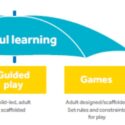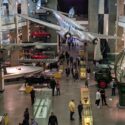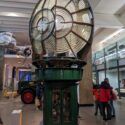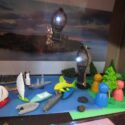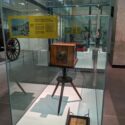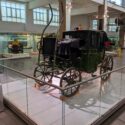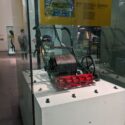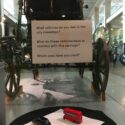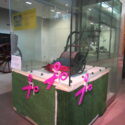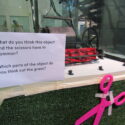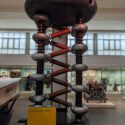Supporting young children’s learning from science objects: the importance of play on gallery
Article DOI: https://dx.doi.org/10.15180/231906
Abstract
Experiences during the early years shape our lives as adults, including our appreciation and understanding of science. Even though early years audiences make up a significant number of visitors in many museums, they are an under-researched age group, particularly in science museums. This paper addresses this gap by considering young children’s learning at the Science Museum in London. Two approaches to support learning from unfamiliar objects were tested with 4–7 year-olds in family groups. The first approach involved families creating a display that featured a small replica of the original object. The second approach involved displaying familiar objects or modern versions with conversation prompts next to the original objects. The testing included observations and semi-structured interviews with a total of 16 family groups. Findings show that families use play to create familiarity and context around objects. Guided play provides opportunities for families to tap into their existing understanding and interests, and in this way allows families to learn from objects. These findings highlight the importance of providing for and encouraging play on gallery to support young children’s learning from objects. Young children can successfully be supported to learn from unfamiliar objects in object-rich galleries in a science museum.
Keywords
early years, families, informal learning, museum learning, object-rich gallery, objects, play, Science Museum
Introduction
https://dx.doi.org/10.15180/Museums aim to provoke inspiration, interest and learning amongst their visitors, including families (Falk et al, 2007). Families are important visitors for museums in that they provide a stream of income, for example through entrance fees, and through a justification for public funding and private sponsorship. Museums in general also have a public duty to offer access to their collections for visitors of all backgrounds and age groups (National Heritage Act, 1983). In addition, most museums aim not only to provide access, but also explicitly aspire towards being recognised as welcoming and relevant settings for families to enjoy themselves and to learn (Museums Association, 2021). For example, the Science Museum Group[1] (SMG) is committed towards an equity-focused approach that builds on diversity and inclusion, and in which science is made attractive and accessible to all, including to families (SMG, 2022). In recent years these aspirations to be family-friendly have frequently included an explicit consideration of the early years (e.g., Kids in Museums, 2019).
The Science Museum in London receives over three million visitors per year. This includes around half a million children aged 0–8 years, most of whom visit as part of family groups.[2] The early years are therefore a significant audience group for the museum. Early childhood experiences shape our lives as adults. For example, there is a strong link between early childhood engagement with culture and adult participation in culture (Oskala et al, 2009). There is also clear evidence that early childhood experiences are associated with academic attainment (Department for Education, 2012). Recognising the early years as a distinct and important group of learners, the UK government introduced the Early Years Foundation Stage (EYFS) for England in 2008, which sets standards for learning, development and care of children from 0–5 years. These standards were revised in 2012 and again in 2017 and apply to all settings that work with the early years age group, including museums. The standards from 2017[3] feature seven areas, of which ‘understanding the world’ is of greatest importance for science learning as it includes encouraging children to explore their environments and consider differences amongst living things and objects (Tunnicliffe and Ghouskou, 2020).
The Science Museum has a history spanning more than ninety years of developing galleries, exhibitions and exhibits for children. These developments include the Children’s Gallery, which opened in 1931, Launch Pad, which operated from the 1980s until 2015, and the present-day WonderLab. The Science Museum also has a long tradition of developing galleries specifically focused on children younger than eight years, such as The Garden exhibition that opened in 1995 and which includes water, construction, sound and light zones, and Pattern Pod, opened in 2000, which introduces the idea that there are patterns all around us. Throughout these ninety years of developing experiences for children, the Science Museum has accumulated significant understanding about ways to engage children with science in informal learning spaces. This understanding stems from academic collaborations with various partners, including University College London (UCL), King’s College and the University of Edinburgh, as well as the Science Museum’s own audience research team. A key priority for the SMG going forwards is the early years audience. The SMG has a commitment to embed child-centred thinking around early years engagement across its learning programmes, interactive galleries and new galleries, including plans to develop a new early years gallery at the Science Museum.
The Science Museum has a diverse and significant object collection spanning over seven million items related to science, technology, engineering, mathematics (STEM) and medicine. One of the missions of the Science Museum, in line with other science museums, is to effectively use these object to engage visitors with STEM. Central to this work is a society in which all people feel that STEM is ‘for them’ and that they have opportunities to access the social and economic benefits that STEM brings. These aims, prior research findings, and associated government standards, and the specific mission of the Science Museum Group suggest that there is huge potential to set early years audiences on a path towards appreciating and learning about science throughout their lives (Raikes, 2019). However, most research considers interactive exhibits aimed at children aged eight years and older (SMG, 2019) and there is only limited research on young children’s engagement with objects, particularly in science museums. This paper aims to fill this gap by addressing the research question: How can young children’s learning from unfamiliar objects in a science museum be supported? It presents findings from research that tested two approaches to supporting learning from unfamiliar objects. The research was conducted with early years children in family groups at the Science Museum in London in August 2021.
The research outlined in this paper is part of a larger project entitled ‘Early Years and Objects’ that aims to understand how young children engage with museum objects related to STEM, and how young children’s curiosity and learning from museum objects related to STEM can be supported. The project involves a collaboration starting in 2019 between the SMG and the Helen Hamlyn Centre for Pedagogy (HHCP) at the UCL Institute of Education.
Prior research and conceptual framework
The prior research and conceptual framework that informs this paper focuses on two areas: family learning in museums, and the role of play.
Family learning in museums
Conceptualising learning primarily as the acquisition of knowledge has long been discredited as overly simplistic in that it falsely views learners as passive recipients (Dewey, 1938). Rather, learning is an active process, with the context providing some content for the learning experience, but the learner ultimately shaping and directing the learning. Learning is therefore most successful if the learner has choice and control (Hein, 1998). Even young children are pre-prepared to learn in this co-constructed way, by actively seeking out opportunities to learn and to connect learning experiences to their prior understanding (Baker et al, 2021). Learning in museums can also be conceptualised as an active process, with visitors creating their own learning experiences. This includes learners verbally expressing emotions, linking information to prior knowledge and understanding, being inspired to find out more, gaining new skills, asking questions and engaging with others (Allen, 2002; Falk et al, 2007).
Families have, and continue to develop, understanding and skills related to science based on everyday interactions, shared experiences, views and dispositions (Banks et al, 2007). Museums can be places for families to engage with science, and to enjoy, learn about and appreciate science (Falk et al, 2007). Children in family groups are active participants in family learning, making choices about how to engage and contributing their ideas and insights (SMG, 2018). Currently the overwhelming majority of research on family learning in museums focuses on families with children aged eight years and above and this research evidences the great potential of museums to support science learning, including amongst families. When visiting museums family members talk to each other, they interact with objects and information provided, and they reflect on elements of their visit that are of interest and relevance to them (Bell et al, 2009; Bevan et al, 2013). Yet, there is only a limited amount of research on young children learning from objects in science museums. This research, as well as research with young children in non-science settings (such as children’s museums), highlights that young children perceive museums as places in which they can see ‘special things’, including objects (Piscitelli and Anderson, 2001). Children are attracted to a range of diverse objects, including particularly large objects, collections of particularly small objects, authentic objects and humorous objects. While children are primarily drawn to familiar objects, they are also attracted to unfamiliar objects, if appropriate support is provided. This support includes relating the unfamiliar object to children’s prior knowledge, interests and experiences; and allowing children to exercise choice and control over where to focus their attention, while simultaneously providing structured support (Flewitt et al, 2019). Family members are important in providing support as they have a rich knowledge of their children’s interests and experiences and can therefore optimise children’s learning from objects (Crowley et al, 2001). Support can also involve the design of specific activities, such as those that encourage the use of imagination to re-contextualise objects in a familiar way (Clarkin-Phillips et al, 2018).
Kinaesthetic interactions are also of relevance in supporting young children’s object engagement (Anderson et al, 2002). These interactions involve touch, movement and other physical activity that children often display to show engagement, interest and pleasure. As we begin to understand kinaesthetic interactions as supporting and being an expression of children’s agency and choice, they can be seen as a way of tapping into children’s tacit knowledge and understanding of museums as physical spaces and the content they house. Movement and the body are a central aspect of how children experience museums, and how objects relate to museums and learning (e.g., Hackett et al, 2018). These values and the relevance of kinaesthetic interactions for learning in museums, as well as the importance of embodied learning are, for example, explored in the ‘Move to Learn’ project, which is a multi-site international collaboration of informal science educators and learning science researchers across the UK and US, of which the Science Museum Group is a member. This project seeks to advance understanding of the role of embodied interaction in young children’s learning about science in informal settings.[4] This project investigates how interactive museum exhibits can be designed to help young children express, communicate and develop their scientific thinking through movement. The project’s focus on embedded learning includes the key principle that the human body can play a significant role in cognitive processes. By including physical interactive activities in the learning process, bodily movements and senses can influence cognitive thought processes.
Play and learning
Play is indisputably central to children’s development, especially in the early years. It enables children to explore, understand and interact with their social environments in an age-appropriate and socially and culturally meaningful way (Piaget, 1945; Vygotsky, 1978). The association of learning with play is long-standing and has gathered support in recent years, with playful approaches being noted as effective ways for educators to support learning (Zosh et al, 2017). Playful learning has been described in numerous ways, and can perhaps best be summed up as emphasising the child’s experience as active, willing, pleasurable, flexible and meaningful (Baker et al, 2021). Play is notoriously difficult to define, with researchers suggesting a range of definitions but they all generally highlight that play is a complex and developmentally very important process that is enjoyable, open-ended and involves free choice and experimentation (Rushton and King, 2020). This research focuses on Zosh et al’s (2017) five characteristics of playful learning:
- Joyful: play is based on pleasure, enjoyment, motivation, thrill, and positive emotional responses.
- Meaningful: children find meaning in an experience by connecting it to something that they already know.
- Actively engaged: children are immersed in the act of self-directed effort, are minds-on, whether or not their bodies are activated.
- Iteration: children try out possibilities, revisit hypotheses, and discover the next question that leads to deeper learning.
- Social Interaction: children share their own mind, understand others through direct interaction, and communicate ideas. Children are not only able to enjoy being with others, but also build a deeper understanding and more powerful relationships.
Play can be seen as a continuum that ranges from ‘free play’ to ‘direct instruction’. In this continuum ‘free play’ refers to play that is initiated and directed by children and does not have an explicit learning goal. This kind of play gives children the freedom to explore, enjoy themselves and to discover with minimal constraints. Next, ‘guided play’ is child-led, but directed by adults and has an explicit learning goal, such as for children to understand how something works or to accomplish a skill. ‘Games’ refers to play that is initiated by adults, but directed by children, with set rules. All of these can be seen as playful learning which can take many forms, such as physical games like hide-and-seek, construction play, board games, pretend play with objects, or role play. ‘Direct instruction’ is designed, initiated and controlled by adults, with set rules and constraints. This kind of play no longer falls under the umbrella of ‘playful learning’ as it is entirely directed by adults with learning goals set by adults (see Figure 1 below) (Zosh et al, 2017).
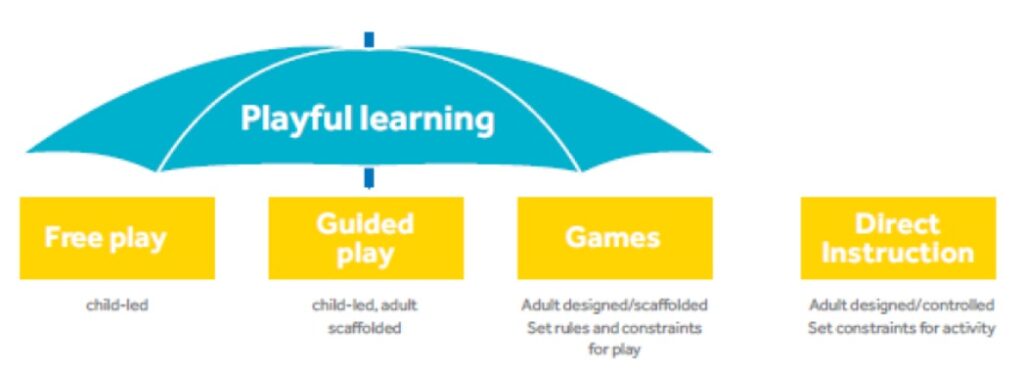
Conceptualising play as a continuum highlights that play does not exist in a vacuum. Play is instead structured by the environment in which it occurs, including the materials available for playing, as well as peers and adults. Learning through play can happen along this continuum through ‘free play’ and when adults or aspects of the environment structure the play situation towards a specific learning goal. Zosh et al (2018) argue that ‘guided play’ is particularly relevant to harness active thinking, meaning-making and joy, and in this manner helps to maximise learning.
A significant body of research highlights that play is crucial for young children’s learning in museums and other informal learning settings (Hope, 2018). Rushton and King (2020) reflect on play to support informal STEM learning for 5–13 year olds in ‘maker spaces’, such as an engineering club. They note that play can be a powerful vehicle to support informal STEM learning if it is based on free choice exploration and imagination. Play within this setting can be perceived as inclusive and inherently successful. It allows children to be autonomous and confident, and to share their ideas and views with peers and adults. This can support the acquisition of STEM skills in a context that children recognise as familiar and joyful. Rushton and King argue that staff in ‘maker spaces’ often describe play as synonymous with open-ended science inquiry. These views chime with notions across the literature that play is the basis for exploration, observation, discovery and experimentation across settings, including in museums (Henderson et al, 2007). Children gain interest and understanding when given opportunities to play, suggesting that play can be considered a starting point for science learning in the early years (Tunnicliffe and Gkouskou, 2020).
Method: outline of objects and prototypes
In this research two prototypes were tested: ‘story box’ and ‘familiar displays’. Both prototypes focus on objects in the Making the Modern World gallery at the Science Museum (see Figure 2).
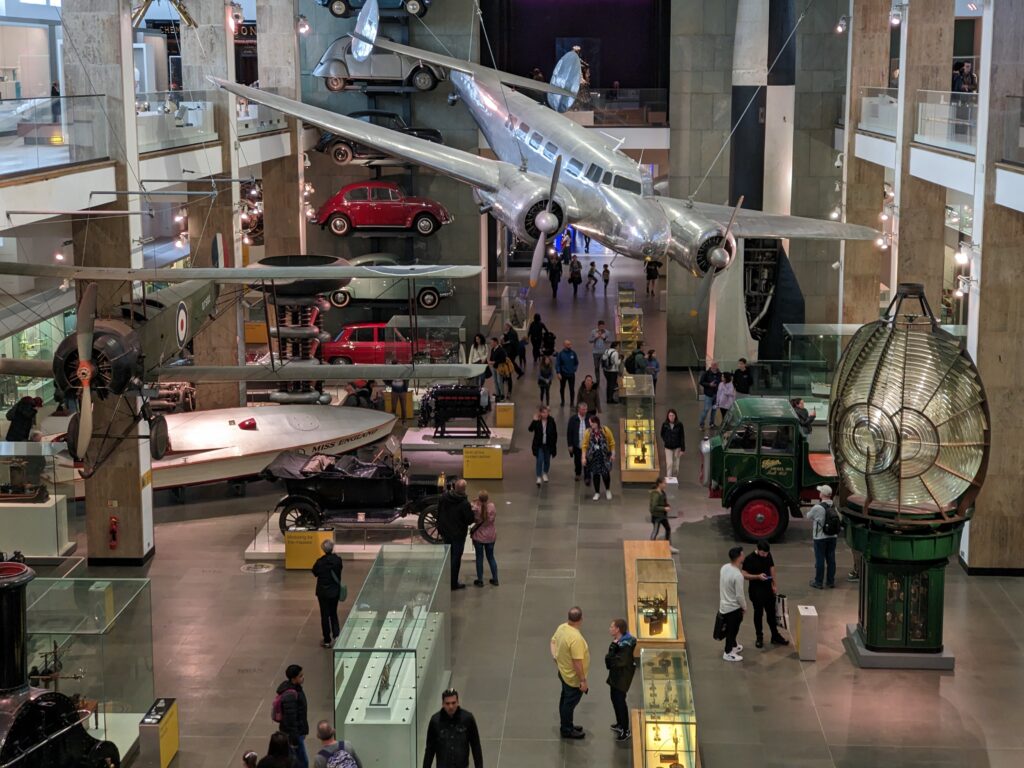
The gallery presents the cultural history of industrialisation from 1750 to the present day by showcasing 150 of the Museum’s most iconic items. Both prototypes focused on objects that prior research on the ‘Early Years and Objects’ project suggests are unfamiliar to young children in that they do not immediately recognise what the objects are, what they are used for and what their significance is.
The ‘story box’ prototype approach focused on the Eilean Glas Light (1907), which is a lighthouse lens that helped sailors navigate Scottish coastlines. Concentric rings of glass combine to make one huge lens. The lens focused the light into three powerful beams so that it could be seen from a great distance and in adverse weather conditions (see Figure 3).
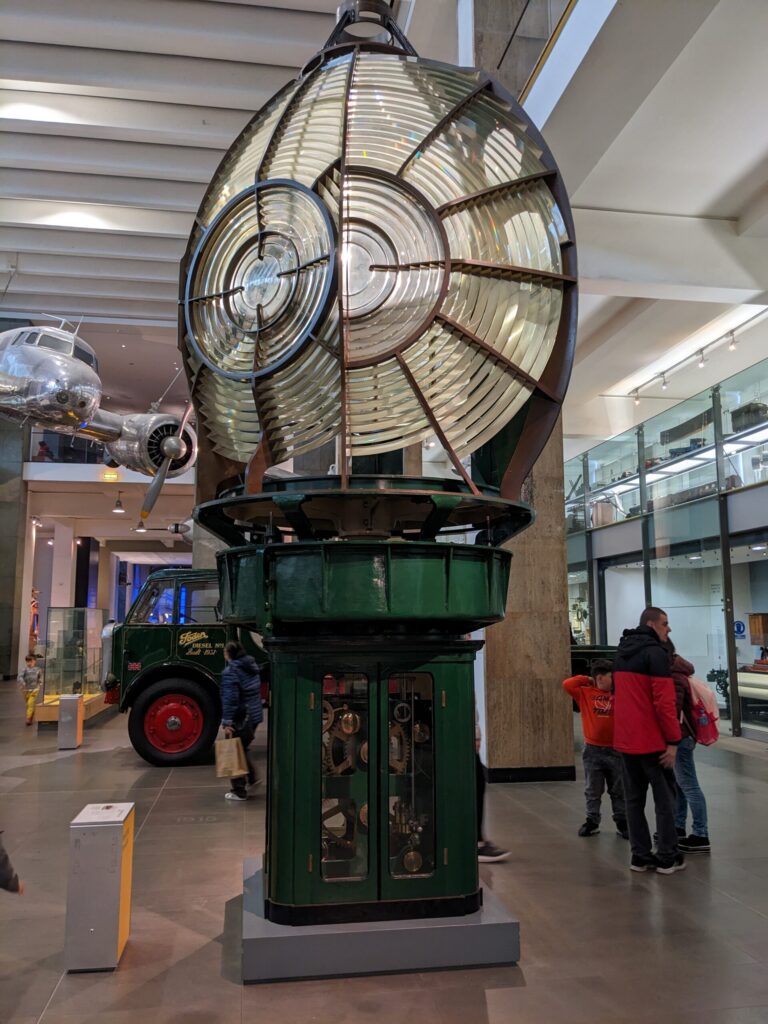
The ‘story box’ prototype involved asking children to learn about the Eilean Glas Light by creating mini displays that featured a toy lighthouse directly next to the Eilean Glas Light on gallery. Children were provided with a small box picturing a backdrop of a rocky coastline, a surface coloured to indicate sea and land and a selection of objects, including boats, people, fish and trees. These objects could be placed within the setting to create a mini display or a small world version of the lighthouse and its setting (see Figure 4).
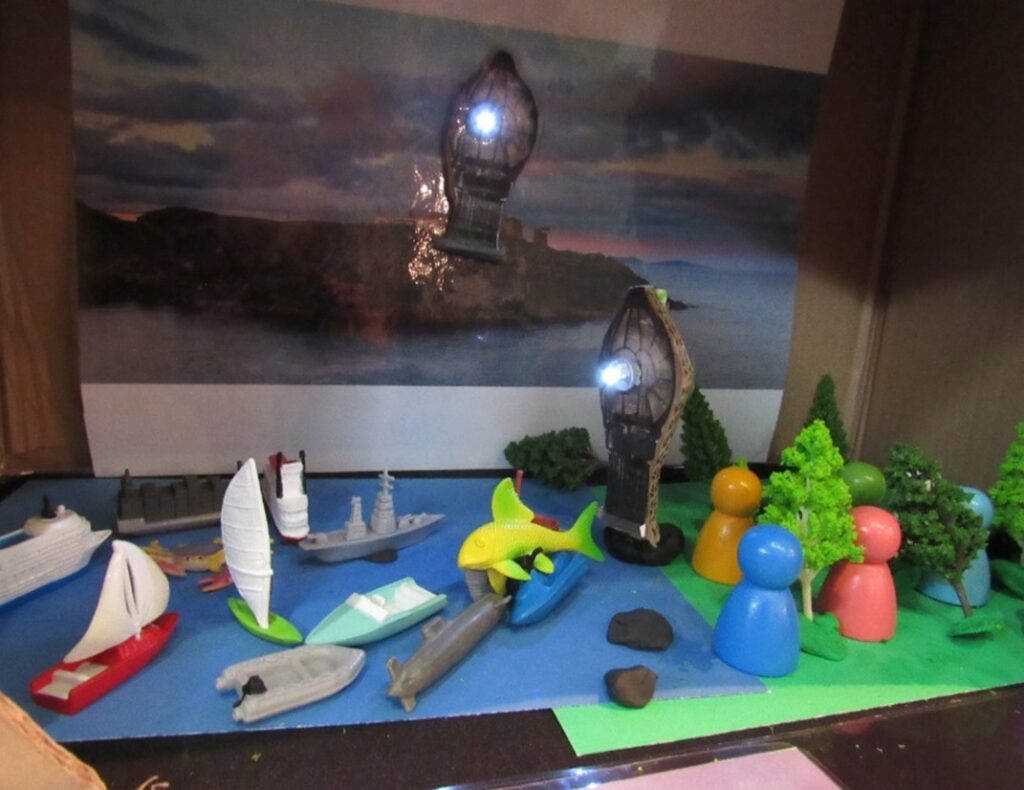
The ‘familiar displays’ prototype approach focused on the following objects: Daguerreotype Whole Plate Camera, Brougham Carriage, and Budding’s Lawnmower. The Daguerreotype Whole Plate Camera (1840) is significant because it shows the first commercially successful photographic process (see Figure 5). Brougham Carriage (1838) is a horse-drawn carriage that marked a key change in the design to be light and compact, and drawn by a single horse (see Figure 6). Budding’s Lawnmower (1832) is an early example of the first lawnmower (see Figure 7).
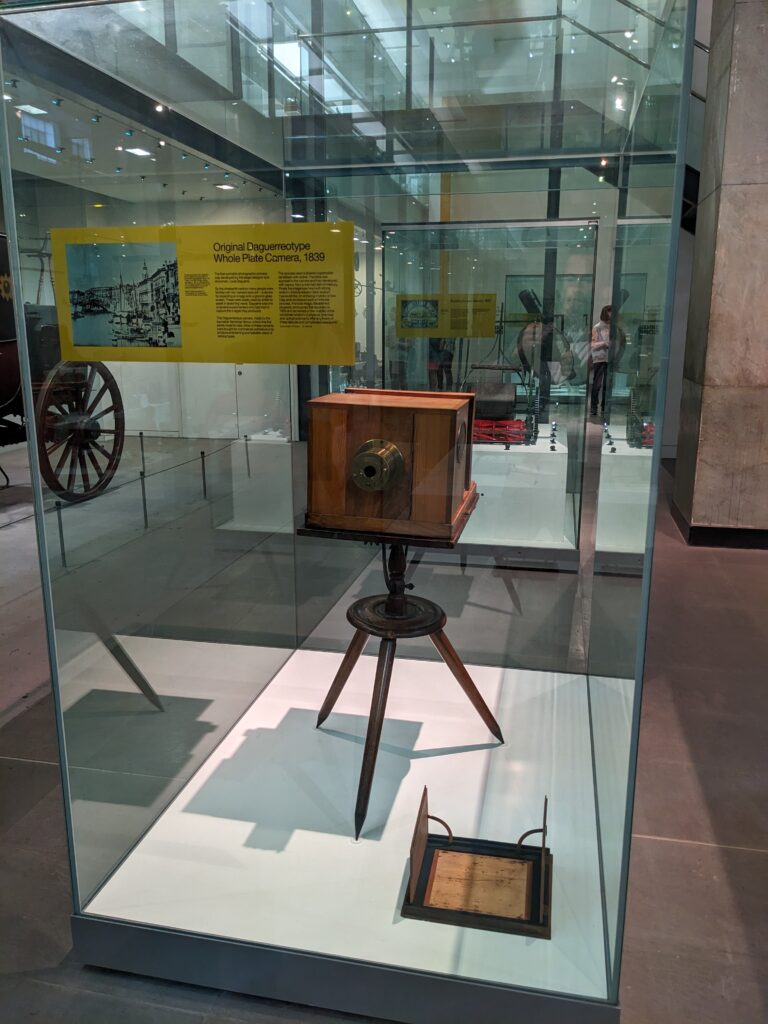
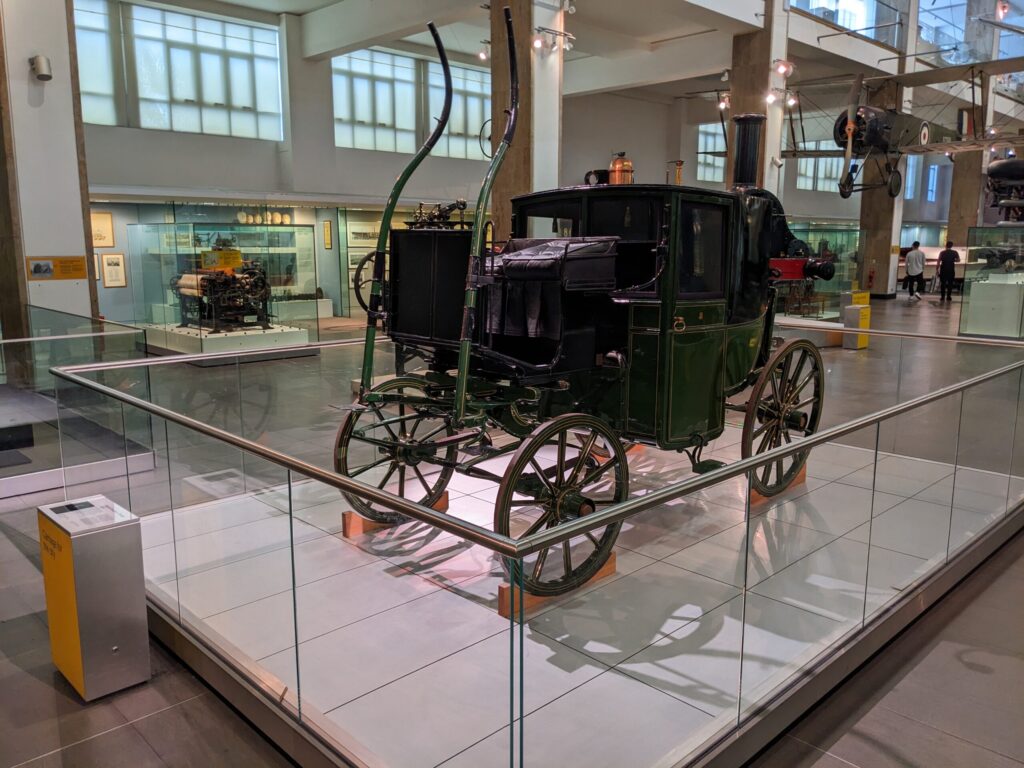
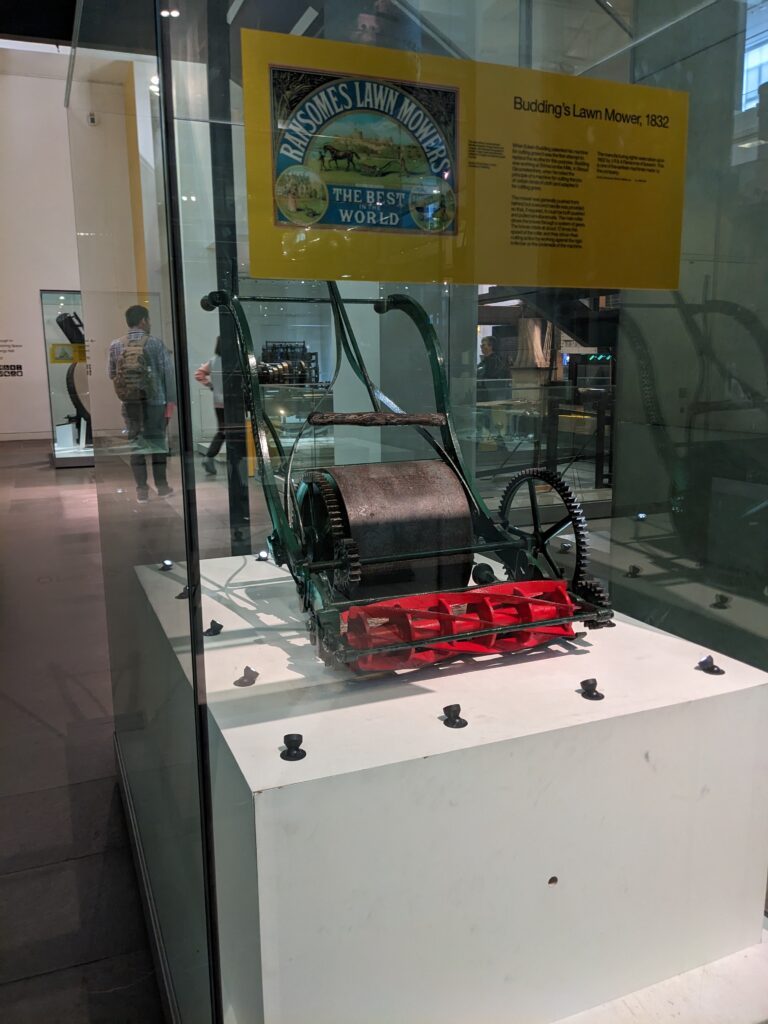
The ‘familiar displays’ concept involved displaying various prompts and familiar objects or modern versions next to the original objects on gallery. The Whole Plate Camera was displayed with conversation prompts, examples of photographs taken by this type of camera, an example of a modern style of photography (a family taking a ‘selfie’ with a phone), and a disposable camera with the negative film exposed.
The Brougham Carriage was displayed with conversation prompts and small toy cars which represented modes of transport found in London today (see Figure 8).
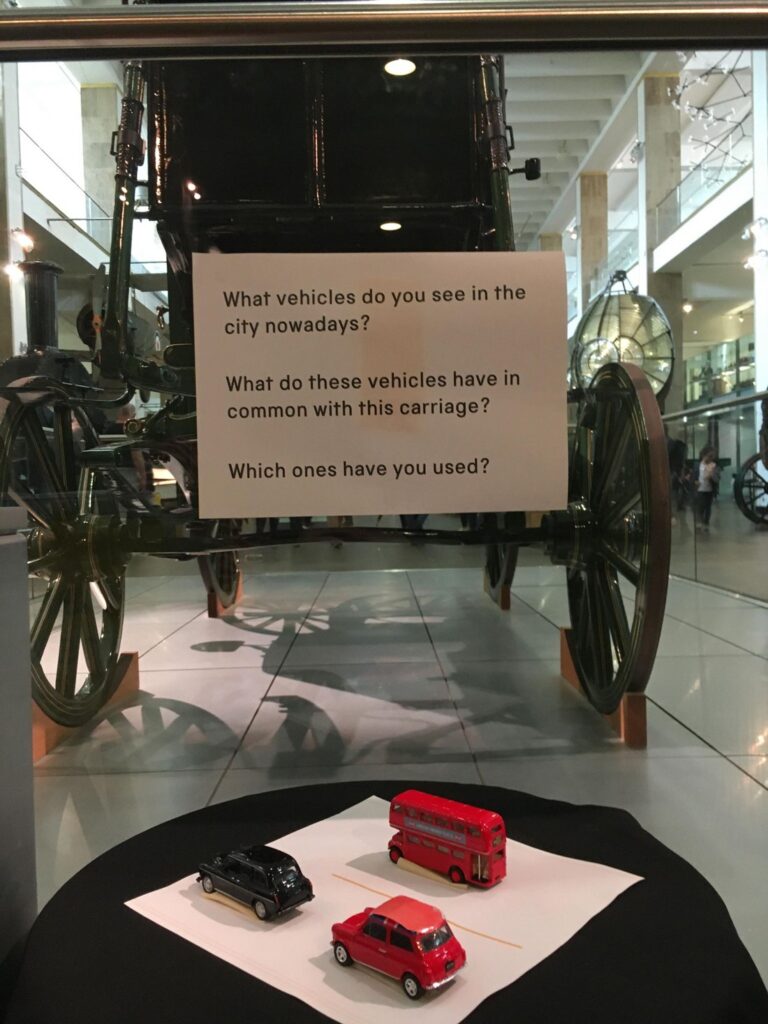
Budding’s Lawnmower was displayed with a pair of giant pink scissors that were stuck onto the object case. The prototype also provided conversation prompts on a label on the object case, such as ‘Why do you think this is here?’ and ‘What do they both have in common?’. The aim of the prompts was to support families to engage in conversations about the object (see Figures 9 and 10).

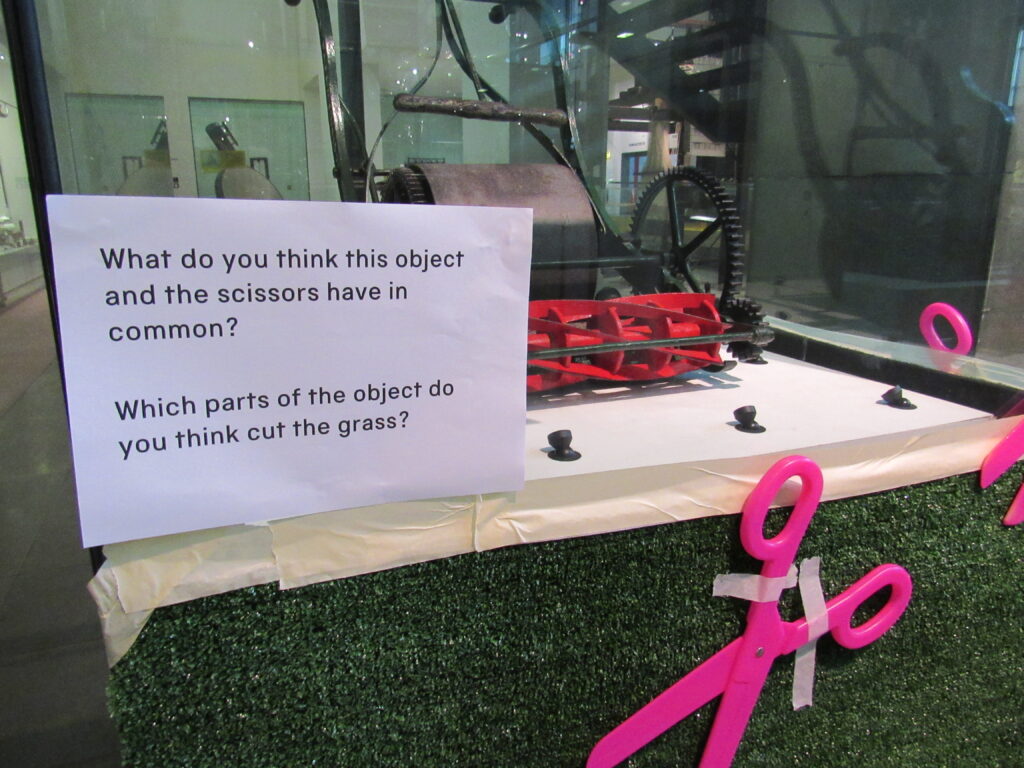
Both prototypes were carefully designed based on a prior evidence assessment of early years learning in museums (Flewitt et al, 2019) and a brainstorming workshop with 19 experts in the field of museum learning and early years (SMG, 2019). The evidence assessment and workshop were both part of the ‘Early Years and Objects’ project. This work highlighted the potential of talk and playful experiences to build on families’ existing understanding and interests and these prototypes aimed to test this assumption. The overall objective of both prototype approaches was to support science learning through play by enabling families with young children to talk about the objects by creating their own meaningful context and familiarity around the objects through imagination, creativity and prior knowledge and experience.
Method: participants
A total of 48 participants consisting of 20 children and 28 adults in 16 family groups took part in the research (see Table 1 below).
| Story box prototype | Familiar displays prototype | |
| Number of family groups | 8 | 8 |
| Number of children in family groups | 8 | 12 |
| Number of adults in family groups | 13 | 15 |
Table 1: Research participants in the prototype testing
All children were aged 4–7 years, with a mean age of 5.8 years. Most families consisted of one adult and one child, or two adults and one child.
Data collection and analysis
The testing was conducted in the Making the Modern World gallery in August 2021. Families were approached on entering the gallery and invited to take part in the prototype testing. Data collection took place during the Covid-19 pandemic, which meant that few families were on gallery, making data collection challenging. Therefore families were not selected to have specific characteristics, other than each family including at least one child aged between 4–7 years. Families who happened to be on gallery during the data collection timeframe were recruited to take part. Future research could involve a more specific inclusion of diverse families, such as families from under-represented groups at the Science Museum.
All families were briefed about the research aims and their involvement in the research, and verbal consent was obtained from adults for their family to take part. Data collection occurred through observation and semi-structured interviews. Families were observed while engaging in the story box activity (for the ‘story box’ prototype) or with the display (for the ‘familiar displays’ prototype). Observation notes were taken, based on a previously developed observation guide that focused on an overarching qualitative research approach. For example, the observation focused on describing what families did and said rather than counting instances of specific behaviour or talk. The observation focused primarily on verbal interaction amongst families rather than on kinaesthetic non-verbal interaction. This focus on verbal interaction is grounded in a view of learning as often being primarily expressed through talk (e.g., Allen, 2002; Ash, 2004). However, given the emerging understanding of the importance of kinaesthetic learning this focus can be described as a limitation of the present research. Future research around how families with young children engage with STEM objects could include a more specific focus on non-verbal kinaesthetic interaction and gestures to consider how young children engage with and learn from objects.
In this study families were asked to interact with the prototypes by using the provided instructions. For the ‘story box’ prototype these instructions were for asked families to create mini displays that featured a specially made toy version of the Eilean Glas Light on gallery. Families were not provided with further instructions, to allow the activity to be guided and directed by the young children and their accompanying adult. For the ‘familiar displays’ prototype families were asked to engage with the object by using the provided conversation prompts if this was appropriate and useful for them. As for the ‘story box’ prototype, the instructions for the ‘familiar displays’ prototype were minimal in order to gain insights into how families use the prototypes on their own terms. There was no time limit for how long families could take part in the activities. Families spent between 10 minutes and 25 minutes interacting with the prototype, the mean being 14 minutes.
Subsequent to taking part in either of the two activities, families were asked about their views and experiences as part of a semi-structured interview. These interviews lasted around ten minutes. Children also used a drawing elicitation tool to help them share their views and experiences. In line with prior research (e.g., see Bell et al, 2009; Bevan et al, 2013) this tool was used as a prompt for questions during the semi-structured interviews rather than as a data collection approach in its own right.
Data analysis was based on open coding and thematic analysis, in alignment with prior research that considers play, engagement and learning in museums (e.g., Rushton and King, 2020). This approach involved assigning codes to the interview and observation notes to determine aspects linked to the research question (‘How can young children’s learning from unfamiliar objects in a science museum be supported?’) by bearing in mind the noted prior research and conceptual framework. This was an inductive process that was shaped from ‘the bottom up’ by directly using the data (interview and observation notes) to develop findings through thematic analysis. Thematic analysis is in this manner a way to analyse qualitative data that identifies meaningful patterns across data (Braun and Clarke, 2006). All data were coded bearing in mind the already identified codes. This constant comparative method (Glaser and Strauss, 1967) allowed for the continuous comparison of newly assigned codes to those that had previously been allocated across the interview and observation notes, and across the family groups. Following suggestions by Merriam (1998), codes that had similar features were grouped together, with a focus on providing answers to the research question. In total 15 overarching codes were identified (see Table 2 below).
| Code | Description of code |
|
Looking closely |
Adult or child looks closely at the object on gallery |
|
Further exploration of object |
Adult or child finds out more about the object e.g., by using text label |
|
Recognising object |
Adult or child recognises the objects on gallery |
|
Understanding purpose of object |
Adult or child understands the purpose or function of the object |
|
Understanding how object works |
Adult or child understands the mechanisms or workings of the object |
|
Question |
Adult or child asks question about the object |
|
Personal connection |
Adult or child makes personal connections to the object, or adds personal context to the object |
|
Express emotion |
Adult or child expresses an emotion in relation to the object |
|
Using additional items |
Adult or child uses or talks about additional items to explain and understand the object |
|
Using conversation prompts |
Adult or child uses conversation prompts provided as part of the prototype to start conversation |
|
What adults and children liked |
Aspects of the object on gallery or the prototype that adult or child liked |
|
Not engaging with object |
Adult or child’s attention/talk/gaze does not include a focus on the object |
|
Object in the story/scene |
Adult or child add the replica museum object to the story or scene |
|
Play |
Adult or child engage one or more of the five characteristics of playful learning |
|
Barriers and improvements |
Adult or child note barrier or improvement to the prototype or their experience |
Table 2: Codes identified
Within this approach to data coding and analysis the researcher’s inherent subjectivity is considered a resource to knowledge production, rather than a hindrance (Braun and Clarke, 2019).
Results and discussion
The findings from the study provide evidence for family science learning during families’ involvement with both prototype approaches (‘story box’ and ‘familiar displays’). All 16 families connected their experience to prior knowledge and understanding, expressed emotions, were inspired to find out more about the object and/or asked relevant questions. This learning was particularly evident for the ‘story box’ prototype activity that not only encouraged families to play on gallery, but also provided a concrete structure for this play. Overall, the findings show that designing for ‘guided play’ on gallery directly supports family science learning from objects as it enables families to tap into their relevant prior knowledge, understanding and experiences.
Both prototypes provided ‘permission’ for families to play on gallery. The prototypes were engaging, fun and relevant to families, which meant that they recognised the activities as playful. This ‘permission’ to play is of great importance in demonstrating to adults and children that museums, including object-rich galleries, embrace the early years as a visitor group. In this research, the families perceived the Science Museum, the Making the Modern World gallery and its objects as ‘for them’. It made families feel comfortable and confident on gallery, and challenged the often perceived seriousness of museums and object-rich galleries (Bevan et al, 2013). In this manner all types of play observed during the prototype activities provide an opening for families with young children to visit museums, to engage with objects and other content there, and to learn science. For example, a mother taking part in the ‘familiar displays’ prototype activity with her two sons aged five years and seven years noted:
The additions to displays (in the ‘familiar displays’ prototype) make the museum more accessible to kids… The additional things draw them in and encourage them to play here at the museum.
Another mother visiting with her seven-year old daughter noted:
We really benefitted from the activity (‘story box’ prototype) in this expansive gallery… It really makes us feel part of the gallery… A playful experience is great for children, it makes it clear that the museum and gallery isn’t just for adults. Every child likes to play.
During families’ experiences while interacting with the prototypes two main types of play were observed: (1) unstructured ‘free’ play that did not directly relate to the objects on gallery and the aims of the prototypes, and (2) ‘guided play’ that did directly relate to the objects on gallery and the aims of the prototypes. As noted above, both types of play are important, but only play that directly relates to objects on gallery can be characterised as families directly evidencing science learning from objects on gallery.
Unstructured ‘free’ play
The ‘familiar displays’ prototype activity supported unstructured ‘free play’ in that it provided all eight families with a cue to be playful on gallery. In addition, the prototype encouraged families to think of and talk about the objects in a way that does not have to be serious or include established science content. While the conversation prompts (e.g., ‘Why do you think this is here?’) placed next to the objects supported family conversations, the prompts did not form part of a playful activity or provide a structure for families to play on gallery. The play that families engaged in during their interaction with the ‘familiar displays’ prototype was consistently initiated and directed by children, without adults or children having a specific learning goal. This play was clearly entertaining and enjoyable to families, but did not explicitly focus on the gallery objects.
During their interaction with the ‘familiar displays’ prototype adults often read the conversation prompts, which resulted in family talk about the objects, such as the properties or significance of objects. Adults in this way were able to make connections between the objects on gallery and the additional items by highlighting similarities and differences, such as the similarities and differences between Budding’s Lawnmower and the giant pink scissors. The question prompts also encouraged adults to ask further questions because they were in the mindset of asking questions, and because they realised that asking questions is a useful way to encourage conversations with their children about objects on gallery. These findings are evidence of family science learning (Allen, 2002; Falk et al, 2007), and support prior findings that labels and other conversation prompts are useful and relevant for learning in museums, including for families (McManus, 1989).
However, it can be argued that the support provided for family learning in the ‘familiar displays’ prototype missed the opportunity to build on and enhance this learning through children’s inherent ability and desire to play. The play that children engaged in at the ‘familiar displays’ prototype often involved touching the additional items on the object cases, such as the pink scissors, and children running around the object cases. This play was largely unrelated to the objects or the conversation prompts and cannot be considered as directly learning from the objects. Children and adults generally did not collaboratively talk about or closely look at the object during children’s play, and in the interviews subsequent to their interaction neither children nor adults mentioned the object as part of their play. The observed play thus did not fulfil the aims of the prototype to enable families to talk about the objects by creating their own meaningful context and familiarity around the objects. During the kind of play observed during the ‘familiar displays’ prototype adults were generally bystanders or supervisors rather than collaborators in their children’s play. Consider the example of six-year old Eva[5] and her mother.
Eva and her mother approach Budding’s Lawnmower in the Making the Modern World Gallery. They are immediately attracted by the giant pink scissors that are stuck on the display case as part of the ‘familiar displays’ prototype. Eva exclaims that the scissors are huge and runs around the display case. She touches the pink scissors and the grass, and engages in playful gestures and sounds, such as to indicate cutting. Eva also mentions how soft the grass is. In response, Eva’s mother says that the scissors look nice, but she does not engage in playful activity, such as gesture or sound. After a short while Eva stops touching and gesturing, and instead runs around the case. Her mother stands by watching Eva. They then both look at Budding’s Lawnmower. The mother reads the question prompts silently, and subsequently re-phrases the questions for her daughter. This includes the mother asking what the object in the object case and the scissors have in common. Eva answers this question, noting that they both cut. The mother and Eva then talk about the differences in how grass is cut with scissors versus with a lawnmower.
This example is typical of how families interacted with the ‘familiar displays’ prototype: children engaged in various kinds of playful behaviours, often being active around the object cases, including touching, running and jumping. The adults accompanying the children tolerated these playful behaviours, but did not take part in them. Family learning at the ‘familiar displays’ prototype focused on adults reading and relaying the question prompts to children rather than on joint playful experiences that enable the creation of meaning for objects in relation to science and the Museum. Children were able to answer these parental questions, which resulted in discussions about the object that did not involve play. This is evidence of family science learning, but this learning was not further supported or enabled through play.
‘Guided play’
The ‘story box’ prototype activity can be characterised as supporting ‘guided play’ in that it provided a clear structure related to an explicit learning goal around a playful experience that adults and to some extent children recognised. All adults correctly noted that the purpose of the prototype activity was to provide a context for the Eilean Glas Light that is relevant and meaningful to families with young children. For example, one father visiting the gallery with his six-year-old daughter described the purpose of the ‘story box’ prototype activity as:
The activity is about the light (Eilean Glas Light)… The activity is educational and shows what the light does, how it works and why it’s there. It helps us understand what the lighthouse is, the context of the light through our imagination.
The ‘guided play’ observed during the ‘story box’ prototype activity clearly and consistently incorporated family science learning related directly to the object on gallery. It made all families engage with the object, in that families looked more closely at the Eilean Glas Light, and talked about it in a context relevant to their lives. Families also showed their engagement with the Eilean Glas Light by talking about its functions, mechanisms, uses and how it relates to present-day objects, such as modern lighthouses, lights or torches. This occurred because the prototype was centred on creating a display, which was an activity that was inherently joyful and simple for families to understand and engage with. There was sufficient space around the activity set up for all family members to gather and see the prototype. The activity was located directly next to the object on gallery and a central part of the activity was a toy lighthouse that was explicitly linked to the object on gallery by referring to the gallery object as a ‘lighthouse’. For all family groups who took part in the ‘story box’ prototype, the familiar props provided as part of the activity, such as fish, sailing boats, people and trees, linked to both adults’ and children’s prior knowledge and understanding. The props elicited memories and experiences that adults and children shared as a family, and incited play, including roleplay, that children and adults jointly took part in.
In response to these features of the prototype, families used play to relate the object on gallery to their prior knowledge, understanding and experiences. The findings show that families have significant existing prior knowledge, understanding and experience that is relevant to objects and that can be tapped into through specific design features, including the use of a known activity and known props. These design features enabled families to create familiarity with and context for the object that allowed all children and accompanying adults to talk meaningfully about and engage with objects.
The ‘guided play’ was supported by the purpose of the prototype activity as supporting family learning clearly being noted. This meant that adults recognised their families’ learning, as well as their own active role in enabling and supporting this learning. As a result, adults directly and purposefully engaged with the play activity rather than being passive bystanders or merely watching or taking on a supervisory role. All adults felt comfortable to play on gallery because they were explicitly asked to as part of the prototype activity. Providing a variety of props during the activity ensured that all family members could establish ownership and agency over the story box creation and narrative as part of the joint play. Consider the example of a mother taking part in the ‘story box’ activity with her four-year-old son Freddie.
The family walk around the Eilean Glas Light and look at it closely. Both the mother and Freddie then look at the props that can be placed in the story box. The mother asks Freddie what the story is about, to which Freddie responds “a lighthouse”. Freddie picks up the model lighthouse and places it at the back of the box. He places other props alongside the lighthouse, using different voices as if acting out a drama story to introduce the props, such as animals and people. The mother joins in with this roleplay, using different voices to bring the characters to life. The narrative that the family engages in contains familiar concepts, such as Freddie noting how dolphins swim in water and the mother noting how the sea can be calm or choppy. Freddie moves the lighthouse near the sea, saying that lighthouses are always near the sea. Through direct questions the mother encourages Freddie to think about why lighthouses are always near the sea, and what lighthouses are used for. Freddie responds by using the people figures to talk about the sea, still using pretend-play voices. The mother continues to take part in the narrative, asking about other animals in the sea, and directly talking to the people and animals in the story box. During the narrative the lighthouse consistently features prominently, with Freddie touching it several times during the activity and moving it from the back of the box into the centre while looking at the Eilean Glas Light. Freddie clearly enjoys playing with the props, such as by laughing and using various different, at times silly, voices for the animals and people, and in narrating the story. Freddie’s mother is visibly comfortable playing with him, confidently and loudly joining in the narrative. The family engage with the ‘story box’ activity for a total of around ten minutes, with Freddie ending the activity by walking away and no longer wanting to talk about the story or the Eilean Glas Light. In the interview subsequent to the family engaging in the activity, the mother says that she was comfortable playing on gallery because the activity required it. She states: “There wasn’t really an option, it’s not the kind of activity that he (Freddie) will just engage in by himself, he wouldn’t just play with it by himself. I think the purpose is quite obvious for parents to take part.”
For Freddie and his mother, as well as for other families, the props that were part of the ‘story box’ activity provided an entry point for conversations about the Eilean Glas Light. In particular, the miniature modern-day replica toy lighthouse was recognised and used by all families as part of their play during the ‘story box’ activity. The miniature toy lighthouse built families’ confidence to speak about the object on gallery, gave the Eilean Glas Light a clear purpose, and therefore made it accessible and relevant to families, including to young children.
The toy lighthouse also prompted adults to reflect on the object on gallery from their children’s points of view. For example, Freddie’s mother asked him why lighthouses are always near the sea, and what they are used for. The ‘story box’ activity in this manner provided opportunities for conversations while adults and children were engaged in play, such as imaginative role play with the toy animals and people. This provided adults with confidence to speak to their children about the object, which in turn encouraged children to engage in the imaginative play more deeply and reflect on their family’s creations in relation to the object on gallery as an integral part of the play. During this playful activity children often sought out information about the object from their accompanying adult, such as who made the object or how the object functions. Play gave adults an opportunity to provide information and answer children’s questions about the object without being overly concerned that the information might not be factually correct. Play was an accessible and non-threatening way for families to engage with an unfamiliar STEM object on gallery: both young children and their accompanying adults were able to use their existing understanding, experiences and interests to engage with and further reflect on the Eilean Glas Light. These findings indicate that designing for ‘guided play’ on gallery supports family science learning from objects. To support such learning, ‘guided play’ must directly relate to the objects on gallery and must clearly be recognised by families as a playful learning activity that all family members collaboratively take part in.
Zosh et al (2018) describe ‘guided play’ as child-led and directed by adults with an explicit learning goal. They argue that this kind of play is particularly relevant to harness active thinking, meaning-making and joy, and in this manner helps to maximise learning. Findings from this study support this assertion, and further highlight that ‘guided play’ can support family science learning in relation to an unfamiliar STEM object. ‘Guided play’ brings the object on gallery to life through imagination and narration, gives it a purpose and makes it accessible and relevant to families. The structure provided by the ‘story box’ prototype activity allowed adults to direct their children’s inherent desire to play on gallery towards specific learning goals associated with the Eilean Glas Light. In the example of Freddie and his mother noted above, Freddie demonstrated an immediate capacity and wish to play with the provided story box by picking up the props, narrating an imagined story and engaging in pretend-play with the animals and people figures. Freddie’s mother joined in this play, such as by directly talking to the animals and people. Crucially, the mother also steered this joint pretend-play towards the learning goals of the ‘story box’ activity, such as reflecting on what lighthouses are used for. The ‘guided play’ that the family engaged in allowed them to tap into their prior knowledge, understanding and interests related to the Eilean Glas Light. This prior knowledge, understanding and interest is embedded in every-day family life, giving ample opportunity and options for all family members to engage in meaningful conversation and interaction with the object. In the example above, Freddie demonstrated his existing understanding related to water animals and lighthouses, which his mother was able to build on and utilise to introduce her knowledge related to different states of the sea – calm versus choppy. Together they established that lighthouses are always near the sea, showcasing and building on a joint existing understanding that they related to the object on gallery. It was not simply the mother conveying her existing knowledge and understanding to Freddie, it was also Freddie conveying his existing knowledge and understanding to his mother. Together they then built on this existing knowledge and understanding to collaboratively establish familiarity around and context for the Eilean Glas Light that was grounded in joint playful experiences, and that enabled and provides evidence of learning.
These kinds of interactions can support families to expand their understanding of objects in a manner that is directly meaningful and relevant to all family members. Families with young children being able to use their prior knowledge, understanding and experiences in relation to unfamiliar STEM objects in museums supports them to recognise the value and relevance of their existing day-to-day interactions and interests, including those of young children, to engage with STEM. It shows how STEM can be made accessible to people across age groups, thus contributing to a more equitable society in which all people, including families with young children, view STEM as relevant to them. In the example above, Freddie and his mother demonstrate that, if appropriately supported to engage in relevant ‘guided play’, they have existing lived experiences that they can utilise to learn from an unfamiliar STEM object on gallery. This learning can be characterised as Freddie and his mother building an understanding of an unfamiliar STEM object through choice and control. This understanding highlights how STEM is accessible and relevant to them, and that they can utilise and further develop this understanding in the future to access the social and economic benefits of STEM.
Reflections on limitations to learning
The Eilean Glas Light is an unfamiliar STEM object because without explicit support families did not recognise it as part of a lighthouse. However, once the Eilean Glas Light was described as a lighthouse as part of the ‘story box’ activity all families had many relevant existing experiences and significant prior knowledge and understanding that linked to the function, mechanisms and uses of the object. This might not be the case for all unfamiliar STEM objects. The function, mechanisms and uses of some unfamiliar STEM objects are likely to less directly relate to families’ lives. The Cascade Generator (1937), which produced the electric field used to accelerate particles of up to one million volts during experiments is a likely example of such an unfamiliar object (see Figure 11).
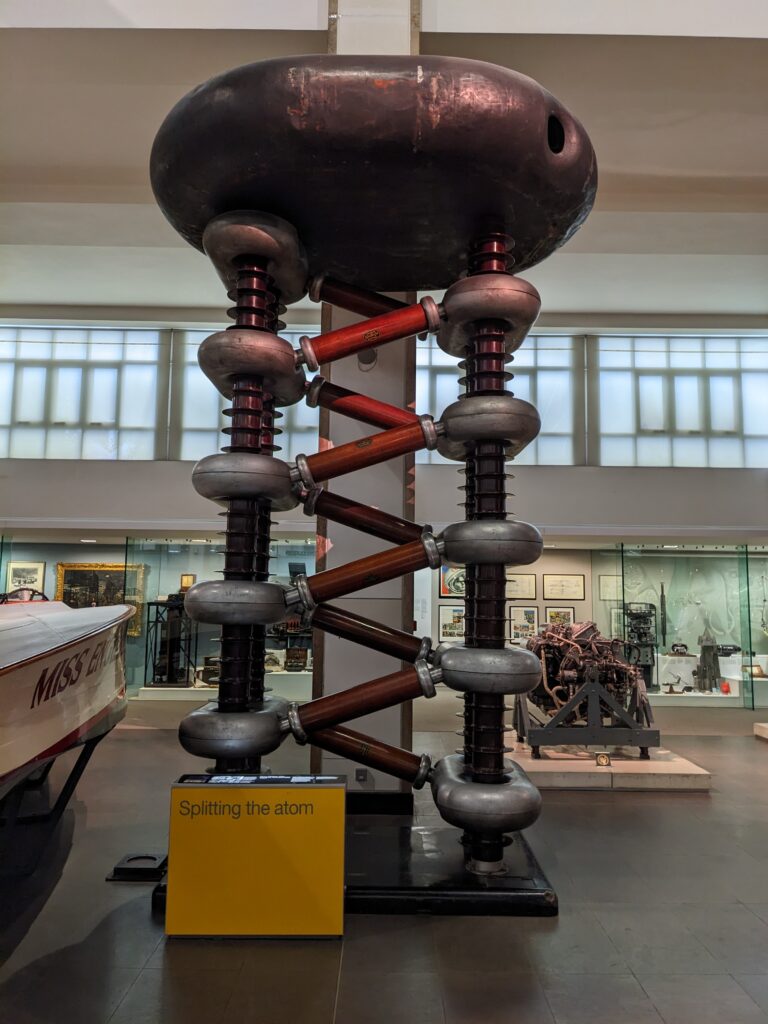
The Cascade Generator was not part of the research presented in this paper, but it nonetheless provides a useful example of the potential limitations of how learning from unfamiliar STEM objects can be supported through play. It is possible that families with young children might talk about the form, colour and size of the Cascade Generator, but it might be more challenging for families to talk about its function, mechanisms and uses as part of ‘guided play’ (see Flewitt et al, 2019). It might therefore be important for museums to carefully reflect on the kind of learning that is likely to be possible and appropriate for young children in relation to unfamiliar STEM objects. In developing approaches to support learning from objects, the uniqueness of objects must not be overlooked. Some unfamiliar STEM objects might be more suitable for early years learning than others.
Conclusion
The purpose of this study was to examine how families with young children can be supported to engage in science learning from unfamiliar STEM objects in a science museum through playful experiences. The findings from the study indicate the importance of play to make families with young children feel welcome on gallery, so that these families recognise science museums, including object-rich galleries, as ‘for them’. ‘Guided play’ is of specific importance in that it provides families with opportunities to utilise and express their prior knowledge, understanding and experiences related to an unfamiliar on-gallery object in a manner not possible during family interactions and conversations that did not involve ‘guided play’. Family groups, including young children in these family groups, have numerous attributes and interests that are relevant to understanding many unfamiliar STEM objects. These attributes and interests can allow them to collectively build understanding of objects that can enable an appreciation of STEM as accessible and meaningful to them, and which can contribute towards accessing the social and economic benefits that STEM brings. Some unfamiliar STEM objects might be more appropriate for young children to be able to utilise, such as those that relate to young children’s existing interests and experiences than others. Unfamiliar STEM objects that young children encounter in some form in their every-day life or for which the function is evident to young children and their families are likely to link more easily to their lived experiences and interests. These kinds of unfamiliar STEM objects are most appropriate for museums to focus their efforts on when supporting learning amongst the early years age group.
The outlined research has advanced the understanding of how families with young children learn in museums through playful experiences. It shows that the early years age group can successfully be supported to learn from unfamiliar STEM objects in an object-rich gallery. Play is not a distraction from learning in museums. Rather, play is an important if not essential driver of learning for families with young children. A significant implication for museums is that play is valuable and useful to effectively support family science learning from unfamiliar STEM objects. The findings suggest that to support such learning, museums are best advised to encourage and design for play experiences on gallery, especially ‘guided play’ that actively involves adults and explicitly notes specific learning objectives.
Features of the prototype that enable this ‘guided play’ included props that adults and children are familiar with and that directly relate to the object on gallery. In addition, it is important to ensure that adults and children can jointly engage in playful activity by providing sufficient space for interaction and by ensuring that all family members are able to see and take part in the prototype activity together. An important feature of the prototype that enabled ‘guided play’ was clearly stating the joint learning goals of the prototype and the active role of the accompanying adults as part of this. These features can be used for the development of resources to support family groups with young children to learn from unfamiliar STEM objects in museums. Further research could focus on a more thorough exploration of how kinaesthetic, non-verbal interaction as well as how embodied learning contributes towards learning from unfamiliar STEM objects.
Overall, the findings offer a timely addition to a recent increased focus on the values of play for learning (Zosh et al, 2017) and the significance of the early years for education (Department for Education, 2012). The findings provide suggestions for how to harness young children’s inherent desire and ability to play for family science learning in an object-rich gallery. The findings therefore provide a valuable contribution as to how to engage younger audiences with STEM, and contribute towards the SMG priority and commitment to embed the engagement of early years audiences across learning programmes, including the development of new galleries
Acknowledgements
The research was funded by the Helen Hamlyn Trust, an independent grant-making trust that funds innovative projects aiming to achieve lasting change and improve quality of life.
The research was carried out by Maria Serveta, Ruth Nulty and Madeline Stanley from the Science Museum.





